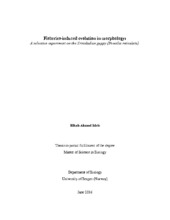| dc.description.abstract | For the past century, the human population has been growing, and the human technology has been advancing, both at historically-unprecedented rates. As a result, the overall impact of human activities on the lives and deaths of the other species has increased to the extent that, in many situations, human-induced mortality has overwhelmed natural mortality. One such situation is commercial fisheries, some of which have been subjected to heavy exploitation for several decades. Because fish harvesting is inherently selective for certain traits (e.g. size and behavior), and because these traits have genetic basis, the evolutionary theory predicts that fishing is capable of driving evolutionary changes in the exploited stocks, and that these changes might take place within contemporary time scales (i.e. decades). Recently, evidence from multiple lines of inquiry (i.e. theoretical modelling, field observations, and selection experiments) are converging on the conclusion that fisheries- induced evolution in the life-history traits (e.g. age and size at maturation, and growth rate) is rapid and ubiquitous, therefore, it has potentially serious consequences on fisheries yield as well as on the viability of the exploited populations. Less is known about the indirect evolutionary effects of fishing on traits other than those directly under selection by fishing gear; these effects might occur either due to genetic/developmental correlations with the directly-selected traits, or as adaptive responses to the demographic/environmental consequences of fishing activities. The present study was conducted with the aim of exploring the potential for indirect fisheries-induced evolution in two aspects of fish morphology, namely coloration and shape; these aspects were chosen because they influence mate choice and swimming performance, respectively. The present study is based on a long-term selection experiment on the effects of size- selective fishing in the Trinidadian guppy (Poecilia reticulata). The selection experiment consisted of two sub-experiments: the harvest and the assay experiments. In the harvest experiment, nine populations of guppies were maintained for multiple generations in the laboratory, and each was assigned to one of three harvesting regimes (three populations were assigned for each of the three treatments): for the positive harvest, large individuals were preferentially removed; for the negative harvest, small individuals were preferentially removed; for the random harvest, the removal of individuals was non- preferential. Harvesting was repeated every six weeks. The assay experiment was conducted once each year, during which, four pregnant females were randomly chosen from each population and were reared under common garden conditions, as well as their first- and second-generation descendants. The selection experiment lasted for three years, approximately equivalent to four guppy generations. The investigation of morphology was based on photographs for all the males from two harvests (the harvests 2 and 4) and for the second-generation males from three assays (the assays 1, 2 and 4). Investigation of the color changes was performed by measuring the numbers and the relative areas of orange and black spots. Investigation of the shape changes was performed by using geometric morphometrics for analyzing landmark coordinates. The investigation of the morphology of male guppies revealed a number of changes through time as well as differences between the treatments; some of the differences observed in the harvest experiment did not persist in the assay experiment, indicating that they represent phenotypically-plastic responses to the rearing conditions. Other differences were probably genetic in origin, as they occurred in both experiments. Regarding guppy’s color, the black coloration decreased during the early stage of the experiment, then increased during the late stage. Moreover, and only for the positive line, the orange coloration increased during the early stage of the experiment, then decreased during the late stage. The early increase of the orange coloration in the positive line was explained as an adaptive response to selection against large size; because the orange color is an expensive yet sexually attractive trait in guppies, evolving more orange reflects increasing investment by the males on reproductive effort, consistent with the theoretical predictions regarding the effect of selection against large size on the life history. The late decrease of the orange coloration in the positive line was explained by the relaxation of selection for increased reproductive effort following the reduction in population density and, consequently, the greater availability of resources per capita. Regarding guppy’s shape, the most robust differences were observed between the generations, rather than between the treatments. Specifically, late-generation guppies showed a narrowing in the caudal peduncle, in the dorsal and the anal fins, and also in the dorsal side of the body. The observed changes, especially the narrowing of the caudal peduncle, were explained as adaptive responses to improve steady swimming performance (related to competitive ability) at the expense of unsteady swimming performance (related to predator-escape ability), driven by the release from natural predation. The differences between the treatments, though mostly statistically significant, were neither consistent in direction nor robust across experiments. Interestingly, the treatments differed more clearly during the middle of the experiment than at the end; this pattern was explained as a consequence of the unique demographic histories (i.e. population dynamics) of the treatment lines, that led to variation in the intensity of selection for competitive ability and, consequently, to variable rates of shape change. Overall, the results of the study indicate that indirect fisheries-induced evolution in morphology is possible and could be taking place in the wild; the results also highlight the possibility that the fluctuating selection induced by the demographic consequences of fishing could have important ecological effects on the harvested populations and their biological communities. | en_US |
